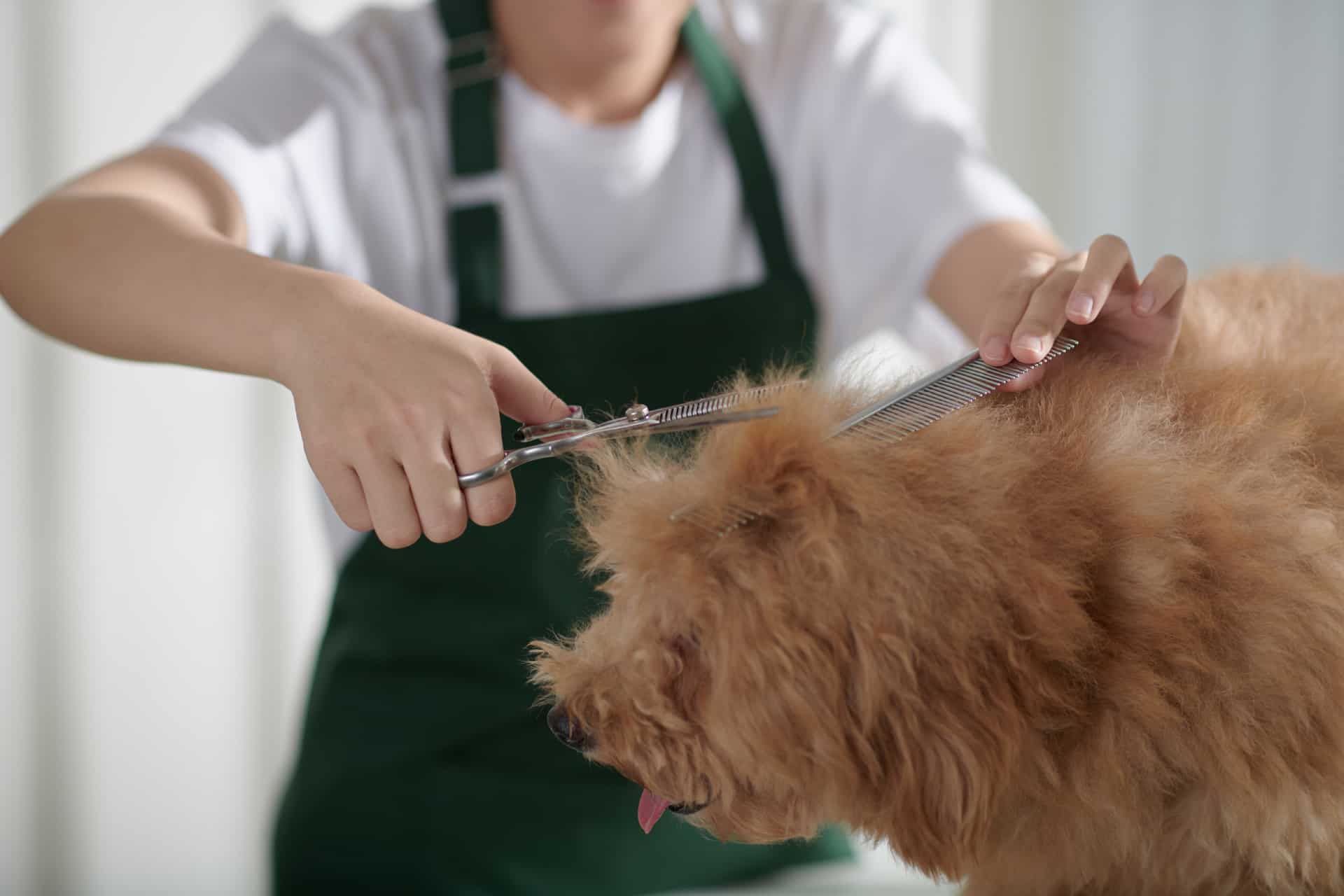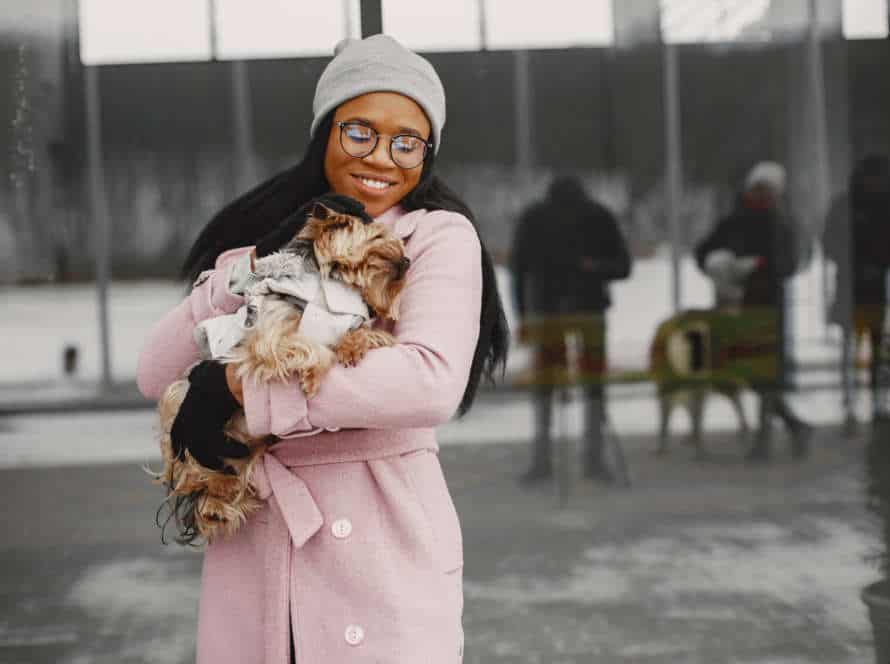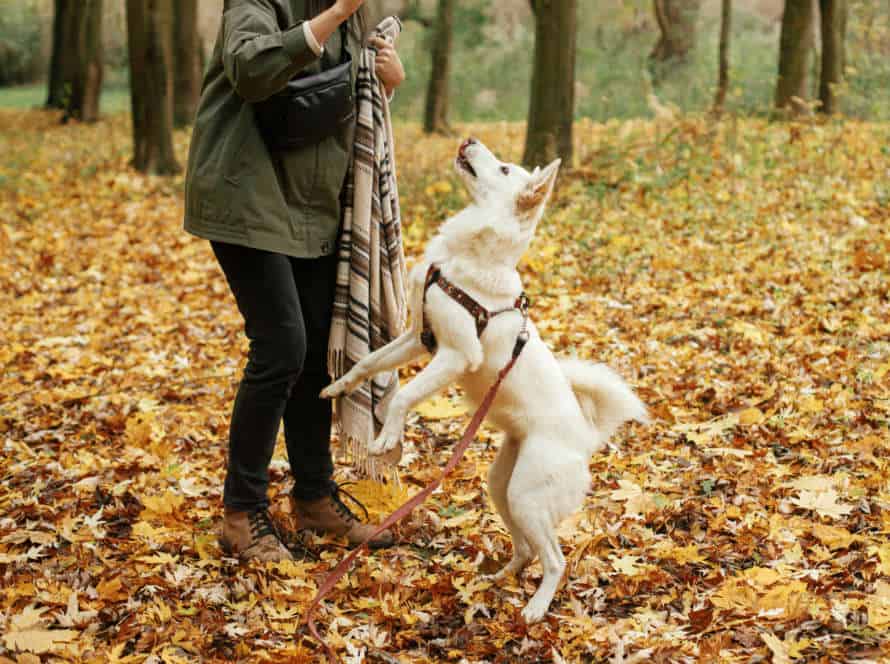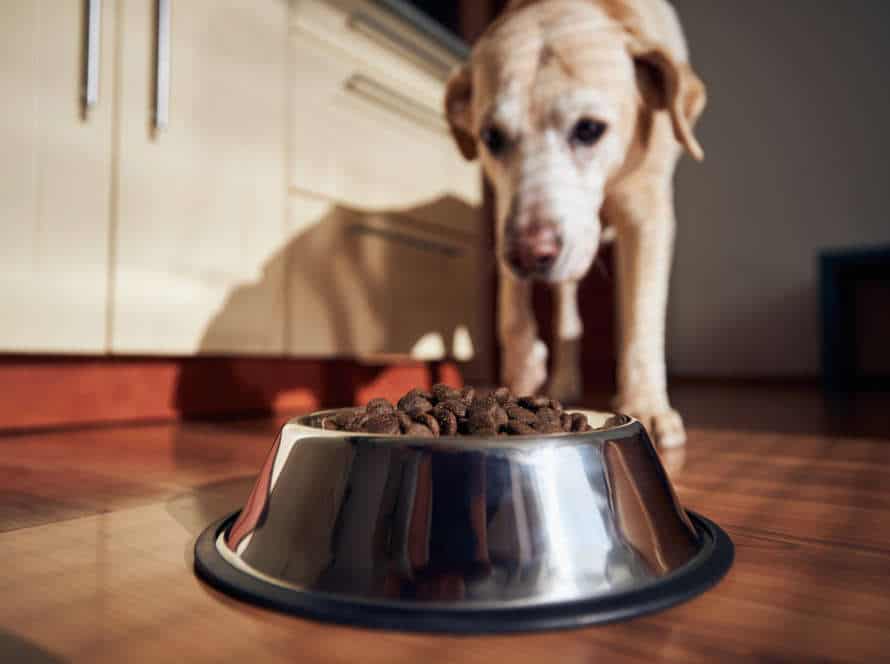Senior Dog Grooming Routines: Tips for a Healthy, Happy Pet
Grooming can help your elderly pup stay healthy and feel their best! Here are some tips to keep your pup looking good:
- Brushing: Use a soft-bristled brush to stop matting, take away dirt, and spread skin oils. This can also help circulation and ease achy joints.
- Bathing: Bathing can help dry/itchy skin and make your pup’s coat shine. Use a mild shampoo and warm water.
- Nail trimming: Trim your pup’s nails regularly. Be careful not to cut too close to the quick, as it can cause pain and bleeding.
- Teeth cleaning: Keep your pup’s teeth clean by brushing them, using vet-approved chews/treats, and scheduling professional cleanings as advised by your vet.
A regular grooming routine will make your pup more comfortable, improve their health, and make your bond even stronger.
Basic Senior Dog Grooming Tips
Your senior pup needs regular grooming! As they age, their needs change. Here are some tips to keep them looking and feeling great:
- Proper grooming is key for their health and happiness.
- Ensure their fur is trimmed and brushed regularly.
- Check their nails and trim if needed.
- Clean their ears, eyes, and teeth.
- Give them massages to help with muscle stiffness.
Importance of grooming an aging dog
As your canine companion ages, grooming is essential for their well-being. Senior dog grooming keeps them comfy, clean, and healthy. Here are some tips:
- Brushing: Regular brushing detangles fur, banishes matted hair and dandruff, and spreads natural oils for a glossy coat.
- Bathing: Older pups have sensitive skin, so use mild shampoo and warm water. This removes dirt, parasites, and dead cells, reducing the risk of skin issues.
- Nail trimming: Long nails can be painful. Trim nails to save your furry pal from splitting and maintain posture.
- Dental care: Good dental hygiene is vital for senior doggos. Teeth brushing, dental chews and professional cleanings prevent infection, gum disease, and tooth loss.
- Ears and eyes: Regular cleaning of ears and eyes prevents infections and discomfort.
When grooming, be gentle and patient. Consult a vet if you’re unsure.
Supplies needed for senior dog grooming
Grooming senior dogs needs a few special supplies for their comfort and safety. Here are some must-haves:
- Rubber or non-slip bath mat – to keep your senior pup steady in the tub or shower.
- Mild pet shampoo – regular shampoos may irritate their sensitive skin.
- Soft-bristled brush – for removing loose hair and debris.
- Large towel – warm and soft, to keep ’em from getting cold.
- Nail clippers with a safety guard – to avoid overcutting and injury.
Regular grooming is essential for senior dogs’ health and happiness.
Preparing your senior dog for a grooming session
Grooming your senior pup is a must for their wellbeing and joy. Preparing your older dog for a grooming session can make it less nerve-wracking for both you and your furry friend.
Here are some basic senior dog grooming tips to remember:
- Brush your senior dog’s coat frequently to keep mats and tangles away.
- Use a mild shampoo made for senior dogs to stop dryness and skin irritation.
- Trim your senior dog’s nails regularly to prevent them from becoming too long and causing discomfort or pain.
- Clean your senior dog’s ears and teeth often to avoid infections and dental issues.
- Take breaks while grooming to let your senior dog relax, particularly if they have movement difficulties.
By following these grooming guidelines for your senior dog, you can guarantee they stay healthy and content in their later years.
Bathing and Cleaning Your Senior Dog
Caring for a senior pet is special! To keep them healthy and happy, regular grooming is key. Bathing and cleaning your senior pup is important for their well-being. Here’s the scoop on bathing and cleaning your senior pooch: why it’s important, and the best practices.
Bathing frequency for senior dogs
Bathing frequency for senior dogs depends on their activity, coat and health. As a guide:
- Dogs with oily coats should be bathed every 4-6 weeks.
- Dogs with dry coats – 8-10 weeks.
- If they spend a lot of time outdoors or are active, they may need more baths to prevent skin issues.
- Dogs with allergies or other health issues should get medicated shampoos and baths as per vet’s recommendation.
When bathing, use warm water and a gentle dog shampoo. Afterward, dry with a towel, no hairdryer!
Pro tip: Regular brushing and grooming can help keep their coat clean and healthy between baths.
Choosing the right shampoo and conditioner for senior dogs
Choosing the right shampoo and conditioner is important when grooming senior dogs. This promotes their health and happiness. Here are some tips to consider:
- Look for mild and gentle formulas. This won’t irritate their skin.
- If skin issues, go for medicated or hypoallergenic products.
- Consider the coat type. Some shampoos and conditioners are formulated to address dry, oily or curly hair.
- Avoid harsh chemicals. These can strip natural oils and cause dryness and itching.
- Always read labels and follow instructions.
- Pro tip: Thoroughly rinse your senior dog after shampooing and conditioning. This prevents residue building up on their skin.
Drying and brushing techniques for senior dogs
Keep your senior dog’s coat clean and healthy with two essential grooming techniques: brushing and drying. Start with a slicker brush or comb, working from the head downwards. Pat your pup dry with a clean towel and be gentle around sensitive areas. To speed up the drying process, you can use a hairdryer on the lowest setting, at a safe distance from their skin. Keep an eye on your pup’s behavior and take breaks as needed. Regular grooming will make them feel more loved, as well as prevent potential health problems.
Nail Care for Senior Dogs
Caring for your pet is a must, especially for senior dogs. Nail care is important for them, as age can make their nails brittle and uncomfortable. Proper maintenance is key for their wellbeing. So, here’s how to look after senior dog’s nails correctly!
Trimming your senior dog’s nails safely
Trimming your elderly pup’s nails is a must for their wellbeing and comfort. As they age, nails grow faster and become brittle, causing soreness or even pain if left uncut.
To trim your old dog’s nails securely:
- Gather the equipment you need, such as nail clippers or a rotary grinder and styptic powder in case of bleeding.
- Start by gradually accustoming your dog to the tools and handling their paws.
- Identify the quick, the pink part that has blood vessels and nerves and avoid cutting it to prevent pain and bleeding.
- Work at a slow pace, trimming little bits of the nail or using the rotary grinder until you reach the desired length.
- Don’t forget to reward your dog with treats and compliments after each session to make it a positive and relaxed experience.
Identifying and treating nail problems in senior dogs
As dogs age, their nails may become brittle and hard to manage. This can lead to painful, unhealthy nails that need careful treatment. Here are some common problems in senior dogs and how to identify and care for them:
- Split Nails: If a nail splits or cracks, it’s at risk of infection. Use styptic powder to stop any bleeding and regularly trim the nail.
- Ingrown Nails: Ingrown nails can be very painful and cause limping. Soak the paw in warm water to soften the nail, then trim it gently.
- Overgrown Nails: Nails that have grown too long can cause discomfort and affect your dog’s gait. Make sure to regularly trim their nails and seek veterinary help if necessary.
- Brittle Nails: Nails that break easily may be caused by poor diet or a health problem. Talk to your vet to find out what the cause is and treat it with supplements or dietary changes.
Pro tip: Give treats and praise to your senior dog during nail trimming to make the process less stressful.
Maintaining healthy nails in senior dogs
Senior pups need extra TLC when it comes to their nails. Poorly cared for claws can cause pain and even mobility issues. Here’s how to keep your pup’s nails healthy:
- Check ’em monthly for overgrowth, splits, or damage.
- Trim ’em every 4-6 weeks with pet-specific clippers. Watch out for the quick – the blood vessel inside the nail.
- If you’re not sure, get help from a groomer or vet.
- Keep their diet healthy, with enough protein, vitamins, and minerals.
- Exercise and activities such as walking and running can help wear down nails naturally.
By following these tips, your pup’s nails will stay healthy and pain-free.
Dental Care for Senior Dogs
Senior pooches require extra love regarding their dental care. Without proper attention, your furry friend can endure gum disease, broken and loose teeth, and even infections. It’s imperative to have a routine in place to guarantee your senior pup’s oral hygiene is taken care of. Here are some tricks to assist you!
Importance of dental care for senior dogs
Senior canine dental care is important for maintaining their overall health and contentment. Older pups are more prone to dental issues due to their age. Poor oral health can cause other health problems. Here are the benefits:
- Brushing and dental chews can help prevent gum disease and tooth loss.
- Dental issues can lead to bad breath, but regular dental care can reduce this.
- Dental problems cause pain and discomfort. Regular dental care can help your pet feel better.
- Regular checkups can help your vet detect health issues before they become more serious.
Taking care of your senior pup’s dental health is an important part of their senior grooming routine. Pro Tip: Regular dental care can increase their quality of life and life expectancy.
Signs of dental problems in senior dogs
As dogs age, it’s essential to look for signs of dental issues. These signs include:
- Bad Breath – If your senior dog’s breath smells bad, it can mean periodontal disease or other dental problems.
- Difficulty Eating – Loose or missing teeth, mouth sores, or gum disease may cause your dog to eat less.
- Increased Drooling – Dental issues can make your dog drool more, especially during meals.
- Pawing at the Mouth – Your dog pawing at their mouth or rubbing their face against hard surfaces could mean dental discomfort or pain.
- Behavioral Changes – Sudden withdrawal, irritability, or less activity may indicate dental issues.
Regular checkups and cleanings, plus a good home dental care routine, can help prevent dental problems in senior dogs.
Preventive measures for dental problems in senior dogs
Senior dogs need special care to avoid dental issues. Here’s how to prevent them:
- Brush their teeth regularly with soft-bristled brush and pet-safe toothpaste. This removes plaque, tartar and food particles.
- Give them dental chews or bones. These help keep teeth clean and provide mental and physical stimulation.
- Regular vet visits for check-ups. This can identify problems early and prevent complications.
- Feed them a high-quality, low-carb diet. This stops bacteria growth in the mouth.
- Professional dental cleaning sessions. Start dental hygiene when they’re puppies to avoid major issues later.
Coat Care for Senior Dogs
Your senior pup’s coat care is super important! As they age, it’s likely their fur may become thinner and coarser. This increases matting risk. To keep their coat healthy and knot-free, extra care is needed when grooming.
Here are some top tips and techniques for awesome senior dog coat care!
Dealing with shedding and matted hair in senior dogs
As dogs age, they may shed more and get matted fur. This can cause discomfort and skin issues. As a pet owner, it’s important to follow a senior dog grooming routine. Here are some tips:
- Regular brushing with a slicker brush, dematting comb, and de-shedding tool.
- Bathe less often with mild shampoo and conditioner for senior dogs.
- Take your senior dog to a professional groomer every few months.
- Make sure their diet has essential fatty acids for healthy skin and coat.
- Add omega-3 fatty acids and biotin supplements.
- Be careful when grooming. Ask for help if unsure.
Brushing and trimming techniques for senior dogs
As dogs age, their grooming needs change. It’s essential to use gentle brushing and trimming to keep them healthy and comfy. Here’re some techniques:
- Brushing: Use a soft-bristled brush. Gently brush in the direction of hair growth. Focus on areas prone to matting (e.g. back of ears & under legs).
- Trimming: Use sharp scissors to trim in the direction of hair growth. Avoid cutting too short. Focus on areas prone to matting (e.g. back legs & tail).
Remember to reward your senior pup with lots of love during grooming. Pro tip: Take your senior furry pal to a professional groomer if you’re not comfortable with the techniques.
Dealing with skin problems in aging dogs
As pups get older, they may experience skin troubles requiring extra care. Here are some coat care tips for senior doggos to help prevent and treat skin problems:
- Brush often – Use a soft-bristled brush or deshedding tool. This will spread natural oils, stop matting and tangling, and remove any loose or dead hair.
- Bathe – Bathe your pup with a gentle, moisturizing shampoo made for sensitive skin. Don’t over-bathe, as it removes natural oils and makes skin problems worse. Bathe once a month, or as needed.
- Trim – Keep nails and hair short. Long nails and hair trap dirt, leading to skin irritation and infection.
- Monitor – Keep an eye out for signs of skin problems, such as itching, redness, dryness, or flakiness. Contact your vet if you spot any of these symptoms.
Pro tip: Regular coat care can help prevent and treat skin problems in older pups, keeping your four-legged friend healthy and content in their senior years.
Note: This outline is not exhaustive and can be customized for specific article requirements.
Disclaimer: Tips for Senior Dog Grooming Articles Can Be Customized Based on Breed, Size, and Health
Customizable senior dog grooming routines to consider are:
- Adjusting brush type/frequency based on coat type
- Using tearless shampoo on sensitive skin
- Joint-mobility exercises to make grooming more comfy
By fitting grooming to the senior dog’s needs, pet owners can make sure their pet is healthy and happy.
Frequently Asked Questions
Q: Why is grooming important for senior dogs?
A: Grooming helps to keep your senior dog’s coat healthy and shiny, prevents matting and tangling, removes debris, and promotes good hygiene. Additionally, grooming can help detect any lumps, bumps, or skin issues early on.
Q: How often should I groom my senior dog?
A: The frequency of grooming will depend on your dog’s breed, hair length, and overall health. Typically, senior dogs require more frequent grooming than younger dogs. It is recommended to groom your senior dog at least once a week.
Q: What are the important things to consider when grooming senior dogs?
A: When grooming senior dogs, you should take your time and be gentle. Use a soft brush to avoid any discomfort and try to groom in a quiet and comfortable space. You should also pay attention to any changes in your dog’s skin or coat and adjust your grooming routine accordingly.
Q: Can I groom my senior dog at home, or do I need to take them to a professional groomer?
A: You can certainly groom your senior dog at home, but if you have any concerns or notices any changes in your dog’s skin or coat, it is best to consult a professional groomer or veterinarian.
Q: What are some health problems that can arise if I neglect my senior dog’s grooming?
A: If you neglect your senior dog’s grooming, it can lead to numerous health problems such as skin infections, skin irritations, and matting or tangling which can result in painful hotspots or even require medical intervention. Additionally, neglected ears can lead to ear infections, and dirty teeth can result in dental problems.
Q: Are there any specific grooming products that are best for senior dogs?
A: There are special shampoos and conditioners designed for senior dogs that are gentle on their skin and coat. Additionally, you can use brushes and combs that are designed for older dogs, which have softer bristles that are easier on their skin.







